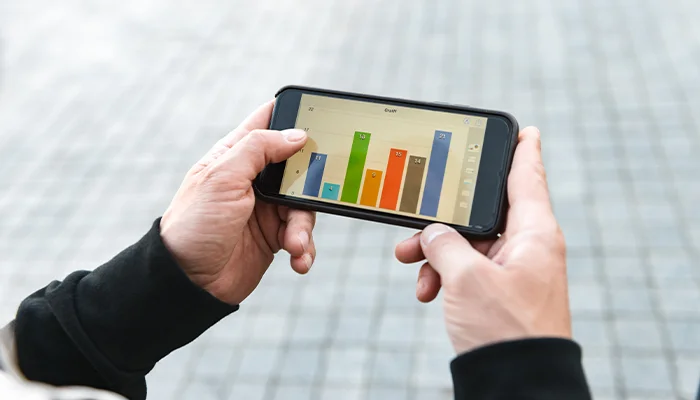
Mobile App Analytics: Tracking User Behavior and Performance
November 14,
17:40 PM
In today’s app-driven world, mobile app analytics has become a cornerstone for understanding user behavior, optimizing app performance, and achieving business success. Without proper analytics, companies risk losing touch with their users' preferences, missing critical performance issues, and failing to capitalize on monetization opportunities. Analytics empowers businesses to make data-driven decisions, helping them fine-tune their apps to better serve their users and improve the overall user experience.
Types of Mobile App Analytics
Understanding the types of mobile app analytics provides a foundation for effective tracking and optimization. These types include:
- User Behavior Analytics: Focuses on how users interact with an app—whether they use specific features, how often they log in, and how much time they spend in the app. Behavior analytics reveal how well the app engages users and where improvements can enhance their experience.
- Performance Analytics: Monitors app load times, response times, memory usage, and crash rates. Ensuring optimal performance helps retain users and prevents churn.
- Revenue and Conversion Analytics: Tracks revenue sources and conversion rates, including in-app purchases and ad revenue, enabling better monetization strategies.
- Retention and Cohort Analysis: Tracks how long users remain engaged and groups users based on shared characteristics, providing insights into user interaction over time.
Key Metrics to Track in Mobile App Analytics
Defining and tracking relevant metrics allows developers to evaluate app performance comprehensively. Here are essential metrics to consider:
- User Acquisition Metrics: DAUs, MAUs, and stickiness ratios indicate user engagement and app popularity.
- Engagement Metrics: Includes session length, screens per session, and frequency of use to measure engagement.
- Performance Metrics: Crash rate, error rate, and load times help maintain app stability.
- Retention Metrics: Retention and churn rates measure user loyalty and highlight areas needing improvement.
- Conversion Metrics: Tracks LTV, ARPU, CPA, and ROAS to evaluate financial performance and efficiency.
Setting Up Mobile App Analytics
Selecting and configuring the right analytics platform is key to success. Popular platforms include:
- Google Analytics for Firebase: Offers event tracking, custom dashboards, and integration with Google products.
- Mixpanel: Specializes in user analytics, engagement tracking, and funnel analysis.
- Amplitude: Provides behavioral insights, cohort analysis, and revenue tracking.
Setting up analytics involves integrating an SDK, defining events to track, and creating custom dashboards to monitor metrics in real-time.
Understanding User Behavior Through Analytics
Analyzing user behavior provides insights into navigation patterns, feature adoption, and pain points. Common areas include:
- User Journey Mapping: Identifies user flow and potential UX issues.
- Feature Adoption Rates: Tracks popular features to prioritize updates.
- Pain Points: Highlights areas where users exit the app, indicating usability issues.
Measuring App Performance and Stability
App performance directly impacts retention and ratings. Tools like Firebase Performance Monitoring and Crashlytics track key metrics such as:
- Load Times: Slow load times can lead to user drop-off.
- Error and Crash Logs: Frequent crashes reduce user trust and lead to uninstalls.
Enhancing User Retention Through Analytics
Retention analytics help identify user engagement trends and improve app experiences. Techniques include:
- Cohort Analysis: Groups users to study engagement patterns and improve experiences.
- Push Notifications: Uses analytics to create personalized re-engagement strategies.
- A/B Testing: Tests different versions of features to improve retention.
Revenue Analytics and Monetization Insights
For monetized apps, tracking revenue is critical. Tools track:
- In-App Purchases and Subscriptions: Highlights spending patterns to inform promotional strategies.
- Ad Performance: Monitors impressions, clicks, and conversion rates to optimize ads.
Tools and Platforms for Mobile App Analytics
There are several analytics tools available, including:
- Firebase: Ideal for user and performance analytics with real-time data.
- Mixpanel: Focuses on user behavior tracking and custom events.
- Flurry: Offers free analytics for startups, covering both user behavior and performance.
Best Practices for Mobile App Analytics
To ensure accurate and actionable data:
- Data Privacy Compliance: Follow GDPR and other regulations to protect user data.
- Clear Metrics and Goals: Regularly update metrics and goals to align with business objectives.
- User Feedback Loops: Combine user feedback with analytics for comprehensive insights.
Conclusion
Mobile app analytics offer invaluable insights into user behavior and app performance. By leveraging the right tools and strategies, businesses can enhance user experience, boost engagement, and maximize revenue.
PerfectionGeeks Technologies specializes in mobile app development and analytics integration. Contact us today to optimize your app's performance and achieve your business goals.




Select a Date & Time
Blockchain Solution
Launching
Testing
Contact US!
India

Plot No- 309-310, Phase IV, Udyog Vihar, Sector 18, Gurugram, Haryana 122022
Copyright © 2025 PerfectionGeeks Technologies | All Rights Reserved | Policy
Contact US!
India 
Plot 378-379, Udyog Vihar Phase 4 Rd, near nokia building, Electronic City, Sector 19, Gurugram, Haryana 122015
USA 
1968 S. Coast Hwy, Laguna Beach, CA 92651, United States
Copyright © 2025 PerfectionGeeks Technologies | All Rights Reserved | Policy








